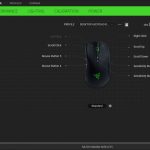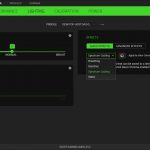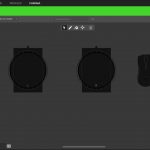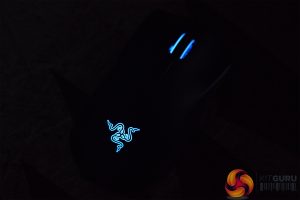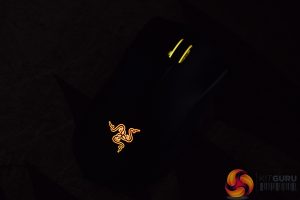To test the Mamba Wireless, I used it as my daily driver for two weeks. We break down testing into four main sections: software, lighting, build quality and comfort, and performance.
Software
Razer's software suite is obviously Synapse – now on version 3. It's overall a pretty effective tool and it's not that complicated either.
Each of the various mouse controls are broken down into several tabs. First up is ‘Customize' which lets you re-map buttons, create different profiles and save up to 5 of them on-board the mouse itself. Next we have ‘Performance' which essentially boils down to setting up to 5 DPI stages and adjusting the polling rate.
‘Lighting' is pretty self explanatory as well, with brightness levels and a bunch of quick effects to choose from, while you can also use Chroma Studio to create your own advanced lighting effects if you like. ‘Calibration' lets you calibrate the mouse's sensor to your mousemat, with a lot of Razer mats pre-calibrated for quick use with the Mamba. And lastly ‘Power' gives you control over how quickly the mouse goes to sleep, and when it should enter the low power mode.
Overall, it's generally a clean and easy to use software suite. I've found it a little buggy in the past and it still gets updates far too frequently in my opinion which just is annoying. When using the Mamba Wireless, though, I've simply had no issues with Synapse – it's given me control over everything I may have wanted to tinker with, and I haven't encountered any bugs or had random crashes.
Lighting
Razer uses its own Chroma ecosystem for the Mamba's RGB lighting, and here it works exactly the same as on the Hyperflux – the Razer logo and scroll wheel are the two RGB zones, and I have to say it looks very good. The colours are nice and vibrant, coverage across the Razer logo is even and brightness levels are also very good. By default the brightness setting is at 67% for the sake of battery – but I found that is more than bright enough for the lighting to be visible at all times.
In short, it is an excellent RGB implementation. Speaking for myself, I would always choose a mouse based on its shape and sensor first and foremost, and RGB for me is secondary. That being said, when you look at the Mamba Wireless with the all-round excellent lighting, it is easy to see how the RGB craze has spread to essentially every corner of the gaming market – it just looks fantastic.
Build quality and comfort
Moving on now to build quality and comfort, I have to say the Mamba Wireless does feel very well built. It weighs in at 106g – so 10g more than the Hyperflux model – which is decent for a wireless gaming mouse, though this year we have seen Logitech's G Pro Wireless which weighs just 80g, so if getting the lightest possible wireless mouse is your priority, that is definitely worth looking at.
Back to the Mamba Wireless, though – it feels generally very solid. There is no creak or flex to the sides of the mouse, the buttons don't have any unwanted pre-travel or post-travel and the main shell doesn't have any issues either. If I were to nit-pick there is some slight scroll wheel rattle, but this was only noticeable when I picked up the mouse and shook it hard – in everyday use and while gaming, I simply didn't notice it.
Still on the subject of build quality, I think it is safe to say there have been a few stories cropping up online about Razer products failing early and generally having issues. Now, I don't know whether this is simply because Razer sells at high volume, so it appears that its products fail at a higher rate than competitors – but all I can say is I have had no build quality issues over the last two weeks with this mouse. I plan on using it more into the future as well, so if anything does happen to my sample, KitGuru readers will be the first to know.
Comfort-wise, the Mamba suits me very well. The size and shape of a mouse is of course very subjective, but generally I get on very well with Razer's ergonomic designs. It is on the larger size, though it is slightly smaller than the DeathAdder Elite, so I wouldn't recommend it if you have smaller hands, but mine measure just under 19cm from wrist to the top of my middle finger, and I got on with it fine.
That was primarily using my preferred claw grip, but I was also able to palm grip it with no problems. I really like the comfort grooves built into the primary buttons, while as I mentioned on the previous page, Razer's rubber side grips also feel great in the hand and I would definitely rather have them over bare plastic.
Performance
Starting with the performance of the Mamba's buttons, both primary left and right buttons use Razer's own ‘Mechanical Mouse Switches', though I believe these are made in collaboration with Omron. In any case, I have to say they are really satisfying to use. They both feel uniform – one of my pet peeves with mice is when one button feels different to the other – and they are generally quite light and responsive. Some people may prefer heavier switches with a bit more snap – in which case the DM1 FPS springs to mind with its Huano blue switches – but for me, these clicks are great.
The scroll wheel is also excellent. It is textured rubber and has very distinct steps so you can really feel it as you scroll, though it is still able to cycle at a fast pace so that didn't prove to be an issue either. It's also relatively easy to click in, when a lot of scroll wheels need a fair bit of force, which for me is a definite plus. There's no option to tune the wheel's resistance as with the Basilisk, but regardless I have to say this is one of the best scroll wheels in the business.
Now we come to the wireless and sensor performance of the mouse. As mentioned, the Mamba Wireless uses Razer's ‘5G Advanced Optical Sensor', and although it has not been confirmed to me, I would expect this to be the PMW 3389. In short, it is excellent – I had no issues with it all, be it angle-snapping, jitter or unwanted acceleration, and it simply tracked perfectly for me whether I was gaming, moving round the desktop or editing photos at low DPI settings.
That ties in with the wireless performance of the mouse, and I have to say I really couldn't tell the difference between using it wired or wirelessly – the connection didn't drop out at all, and latency was a complete non-issue. The only time where I noticed the wireless performance degrade was when the mouse's battery was nearly gone – I found when it was getting to below 30% or so, I would start to notice increased latency and my movements just felt sluggish.
It turns out this was because the mouse enters ‘low power mode' by default once the battery drops past 25%. I was quick to change this setting in Synapse, however, and now it only happens when the mouse is below 5% battery – at which point I'd just plug it in anyway. But if you are experiencing something similar, the low power mode setting is definitely something to look at.
In terms of sensor lift of distance (LOD) as well, I found the mouse would still track with a single DVD wedged under either end, but a second DVD caused it to stop tracking, which is overall pretty standard. It is worth noting there is no LOD control within Synapse, though.
The last thing to touch on is battery life, and I have to say Razer has done a very good job here. During my testing I left LED brightness at the default 67%, but tweaked low power mode to only kick in once the battery went below 5% as mentioned. With those settings, I was able to get between four and five full days use out of the Mamba Wireless.
Bearing in mind I am sat at my desk pretty much all day working on reviews and the like, this really impressed me – I could charge the mouse on Monday morning, and it would see me through to about Friday afternoon off a single charge. More often than not I would forget to switch the mouse off overnight, too, so it would enter sleep mode but not completely shut down – if you were diligent about turning it off every day, you could probably stretch it even further.
 KitGuru KitGuru.net – Tech News | Hardware News | Hardware Reviews | IOS | Mobile | Gaming | Graphics Cards
KitGuru KitGuru.net – Tech News | Hardware News | Hardware Reviews | IOS | Mobile | Gaming | Graphics Cards


